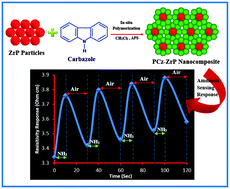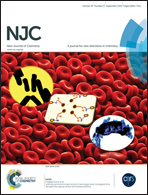Facile synthesis of an electrically conductive polycarbazole–zirconium(iv)phosphate cation exchange nanocomposite and its room temperature ammonia sensing performance†
Abstract
In this study, we reported the synthesis of an electrically conductive polycarbazole–zirconium(IV)phosphate (PCz–ZrP) cation exchange nanocomposite as a new sensing material. Zirconium(IV)phosphate (ZrP) assisted in situ chemical oxidative polymerization of carbazole was used for the synthesis of PCz–ZrP. Field emission scanning electron microscopy, Fourier transform infrared spectroscopy, thermogravimetric analysis and X-ray diffraction analysis were applied to characterize the PCz–ZrP cation exchange nanocomposite. Strong interactions between the inorganic particles (ZrP) and organic polymer (PCz) were observed. Thermogravimetric analysis revealed that the PCz–ZrP nanocomposite had higher thermal stability than pure PCz. Moreover, the composite showed good ion-exchange capacity, electrical conductivity and isothermal stability in terms of DC electrical conductivity retention under ambient conditions below 100 °C. A nanocomposite based sensor was fabricated for sensing aqueous ammonia at room temperature. An increase in resistivity on exposure to ammonia at room temperature was observed with a direct relationship between response and ammonia concentration. The PCz–ZrP nanocomposite-based sensor showed a quick and reversible response towards aqueous ammonia.


 Please wait while we load your content...
Please wait while we load your content...